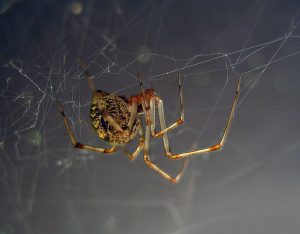What Do Spider Egg Sacs Look Like?
By Chris Williams on June 21, 2016.
I was doing some heavy housecleaning yesterday and kept finding these light brown, soft, round things in corners and on the underside of furniture. They’re about the size of a pea. Are these the eggs of some insect? P. V., Epsom, NH
You’re almost right. I’m guessing that what you were finding were spider egg sacs. Do they look like the photo here on the right? If you’d looked more closely in crevices on the underside of the furniture, you probably would have seen a spider hiding.
Each Egg Sac Contains Hundreds of Spiders!
Our most common indoor spider, the American house spider, can deposit up to 17 egg sacs in her lifetime, mostly in summer and fall. You will usually find two, or three, or four egg sacs (some hatched) all together in the area where the spider is hiding. The papery-looking egg sacs are covered with spun silk. Each globular or pear-shaped sac contains 100 to 400 baby spiders when it hatches. The egg sac also contains some unfertilized eggs that serve as food for the spiderlings before hatching.

American house spider and her tangled web
The hatchlings remain in the mother’s web for several days before venturing out on their own. I actually walked into my office one day to find hundreds of newly hatched spiderlings swarming up the side of my desk! Sure enough, there was an empty egg sac on the backside of my desk. If outside where there’s a breeze, the young spiders will spin silken threads, catch the air, and “balloon” to a new location.
The American house spider doesn’t have a pretty, symmetrical web like the famous storybook spider, Charlotte. Instead, it hangs upside down in its irregular, tangled web. Webs are found near windows (especially behind draperies), and in corners of rooms either high or low, under furniture, and in closets, among other places. Underneath sofas, recliners, side tables, etc. is a common hiding place for spiders because these areas are dark and rarely disturbed.
If You’re Feeding Spiders, Call Colonial Pest
If your home is overrun with spiders, it’s a good bet you also have more than your share of some other insect pests, either as permanent residents or wandering in through doors and windows. Since spiders are predators on insects and other arthropods, they have to be eating something in your home. Typical spider food includes house flies, cockroaches, fungus gnats, carpet beetles, earwigs, food moths, ants, and crickets. Call us at Colonial Pest for a full pest inspection of your home.
For more information on how to get rid of spiders, check out these Colonial blogs:
Photo Credit : “Achaearanea tepidariorum” by Mad Max at English Wikipedia – | CC BY-SA 3.0 via Wikimedia Commons.